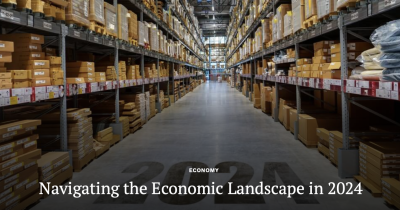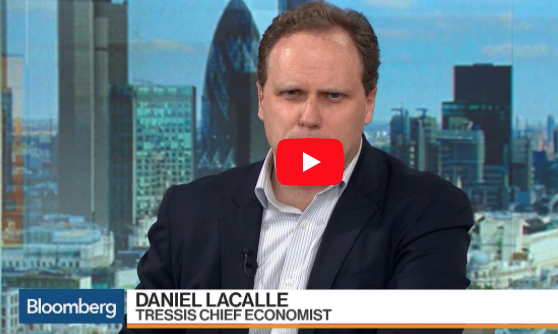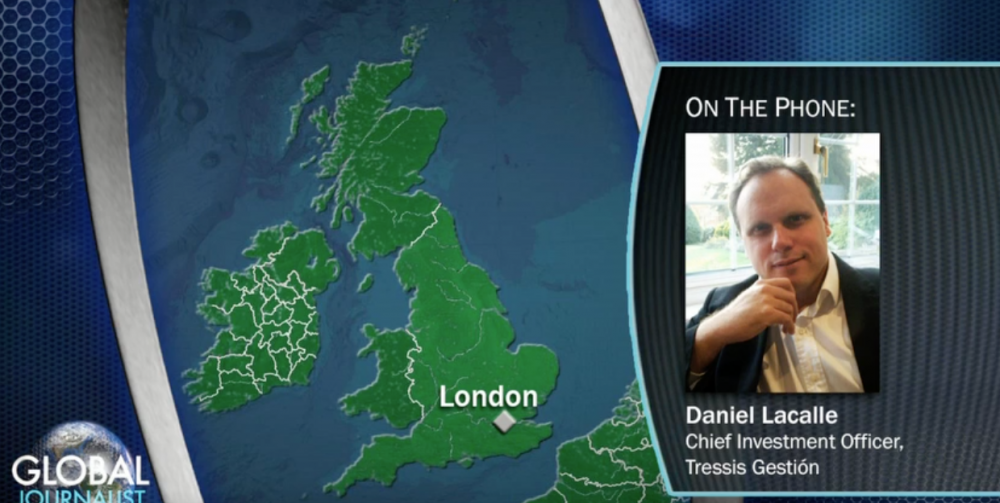
Article originally published in Tomorrow’s Affairs
As we embark on the year 2024, the economic landscape is characterized by a blend of factors, including declining but still elevated inflation, potential interest rate cuts, increasing geopolitical risks, and soaring public debt.
The final quarter of 2023 witnessed a remarkable improvement in market sentiment. The moderation of inflation, strong corporate profits that exceeded expectations, and optimism regarding impending rate cuts all contributed to this surge.
The heightened complacency, evident in the “extreme greed” levels on the CNN Greed and Fear Index, resulted from aggressive rate reduction expectations by central banks and projections of a swift decline in inflation. However, as we move into 2024, parallels with the preceding year become apparent.
Contrary to market expectations, a “soft landing” is not enough to bring about the anticipated year of disinflation; a recession is the necessary catalyst.
An abrupt increase in the global money supply, standing at nearly $107 trillion by the end of the year, remained a bulwark against a recession in 2023, coupled with relentless government spending.
A lag effect
The contrast between alleged tight monetary policy and active fiscal measures has placed the entire negative impact on the private sector, bearing the brunt of rate hikes and declining monetary aggregates.
A manufacturing sector that remains in deep contraction is joined by a services sector that sees how consumers have almost depleted their savings for 2021.
Although inflation declined alongside monetary aggregates, the economic repercussions have been delayed due to a lag effect.
The full-scale impact of the 2023 monetary contraction is expected to manifest in 2024
The full-scale impact of the 2023 monetary contraction is expected to manifest in 2024, leading to a decline in inflation if the economy falters and private sector demand recedes.
However, the notion of a quick slump in inflation with no impact on growth or jobs appears increasingly implausible. Additionally, a looser monetary policy may contribute to commodities rebounding, attracting freshly printed money towards unconventional assets, and making the inflation decline more challenging.
The impact of debt and public spending remains a critical consideration. Will central banks uphold market support? How will taxes and macroeconomic factors shape the global economy? These questions underscore the delicate balance between recovery and potential risks.
A year of stagnation
In 2024, a prudent investment policy is recommended. Central banks are expected to maintain accommodative policies, injecting liquidity selectively. However, anticipated interest rate reductions may not be as significant as expected.
The global economy enters 2024 with less uncertainty. Geopolitical risks seem to have been discounted, and this may be a sign of excessive optimism in a year where global growth is projected to slow markedly, while the Eurozone and Latin America may continue to show worse growth than their counterparts.
2024 will likely be a year of stagnation with elevated public debt
Strong China and India growth will not likely change the weak trend of productivity and growth generated in most developed and emerging economies after years of debt-fueled government spending programs.
2024 will likely be a year of stagnation with elevated public debt. Thus, the expected quantitative tightening is likely to be less severe with a rising global money supply and improved credit conditions.
A risky environment for fiat currencies is anticipated, with ongoing destruction of the purchasing power of the domestic currencies as governments continue to increase their fiscal imbalances.
Gold and bitcoin may help citizens avoid the debasement of currencies without ignoring the large difference in volatility of each asset class.
Global loss of purchasing power is likely to continue even with declining annual rates of rise in consumer prices, with expected global inflation between 3.5% and 4%
Expectations of large rate cuts and even quantitative easing from the Federal Reserve may be too optimistic. In a U.S. election year, substantial changes in monetary policy are not anticipated.
As such, global demand for dollars is expected to rise, creating a favorable environment for dollar-denominated assets.
Numerous risks cast shadows on the economic horizon, including more persistent inflation, unanticipated impacts on business margin and profits, potential currency depreciation in emerging markets, the ongoing China-USA trade conflict, the war in Ukraine and Israel generating widespread geopolitical risk, and the spectre of a black swan event in the debt market causing a credit crunch.
2024 is likely to be very similar to 2023. The long-term trends of weak productivity and GDP growth, high debt, rising government size in major economies, increases in taxes, and erosion of the purchasing power of salaries and savings will continue.
Equities may react positively to looser monetary policy, but the macroeconomic path to stagnation remains.
Latin America Faces Another Lost Decade. Socialist populism is making the region lag peers.
Fox News: My interview in Making Money with the great Charles Payne

Sinopsis de Haz crecer tu dinero
Daniel Lacalle comienza su nuevo libro con esta frase lapidaria: «La inmensa mayoría de lo que has leído sobre inversión y sobre finanzas está escrito por gente que jamás ha invertido cantidades grandes, probablemente ni siquiera inviertan nada».
En Haz crecer tu dinero, el célebre economista e inversor se sirve de su experiencia de dieciocho años junto a los mejores gestores de fondos mundiales para explicarnos cómo preservar nuestro capital, mitigar pérdidas y crear riqueza a largo plazo y para recordarnos que los grandes inversores de la historia no lo son por haber acertado siempre, sino por haber sabido tomar nota de sus errores.
El mundo de la inversión está plagado de buenas intenciones, pero no existen los inversores infalibles. Frente a la falsa imagen que se nos vende del inversor “mago”, Lacalle sostiene que no existe la fórmula del éxito en inversión, pero sí existe la del trabajo: sólo con atención al detalle, aplicando el pensamiento crítico y conociendo de antemano qué funciona y qué no funciona conseguiremos invertir con éxito.
Haz crecer tu dinero es un libro estimulante, rebosante de sabiduría financiera, y una historia de tesón, responsabilidad, trabajo, sacrificio y decisiones acertadas que nos ayudará no sólo a ganar dinero sino también, y sobre todo, a garantizar nuestro futuro.

Milei must now confront this poisoned legacy with determination and courage. Macri, who suffered from the error of gradualism, recently argued that there was no room for mild measures, and he is right.
Milei has promised to shut down the central bank and dollarize the economy. However, can it be accomplished?
The answer is yes. Absolutely.
To understand why Argentina must dollarize, the reader must know that the peso is a failed currency that even Argentine citizens reject. Most Argentine citizens already save what they can in US dollars and conduct all major transactions in the US currency, because they know that their local currency will be dissolved by government interventionism. The government has 15 different exchange rates for the peso, all fake, of course, all of which have only one objective: to steal from citizens their US dollars at a fake exchange rate.
The central bank is bankrupt, with negative net reserves, and the peso is a failed currency. Therefore, shutting down the central bank is essential, and the country needs to have an independent regulator without the power to print currency and monetize all the fiscal deficit, and it must eliminate the possibility of issuing the insane Leliq (remunerated debt) that destroys the currency today and in the future.
Shutting down the central bank requires an immediate and strong solution to the Leliqs, which will have to include a realistic approach to the monetary mismatch in a country where the “official exchange rate” is half the real market rate against the US dollar. Taking a bold step to recognize this monetary mismatch, closing the central bank, and ending the monetization of debt are three essential steps to end a path to the destruction of a country comparable to that of Venezuela. Milei understands this and knows that the US dollars that citizens save with enormous difficulty should flow back to the domestic economy by recognizing the monetary reality of the country making the US dollar a legal tender for all transactions.
The monetary issue is one side of a hugely problematic coin. The fiscal problem needs to be addressed. Milei needs to put an end to the bloated fiscal deficit, and that requires an adjustment that eliminates political spending without destroying pensions. This must involve selling some of the many inefficient and bloated public companies and the excess spending in purely political subsidies. Secondly, Milei must put an end to the ridiculous trade deficit. Argentina must slash the misguided protectionist and interventionist laws if the Peronists are open to the world to export all they can. To do this, it needs to put an end to the ridiculous “currency exchange rate clamp” and the 15 false exchange rates that the government uses to expropriate dollars from citizens and exporters with unfair rates and confiscations.
Taxes need to be lowered in a country that has 165 taxes and the highest tax wedge in the region, where small and medium-sized enterprises pay up to 100% of their sales.
Argentina must change what is currently a confiscatory and predatory state. Additionally, bureaucratic barriers, protectionist measures, and political subsidies must be removed. Furthermore, Milei must ensure legal certainty and an attractive and reliable regulatory framework where the ghost of expropriation and institutional theft does not return.
Milei’s challenges are many, and the opposition will try to sabotage all market-friendly reforms because many politicians in Argentina became very powerful and rich turning the country into a new Venezuela.
If Argentina wants to become a thriving economy that returns to prosperity, it needs a stable macroeconomic and monetary system. It must recognize it has a failed currency and a bankrupt central bank and implement the urgent measures required as quickly as possible. It will be difficult but not impossible, and the potential of the economy is enormous.
Argentina was a rich country made poor by socialism. It needs to abandon socialism to become rich again.

No me preocupa la inteligencia artificial, me aterra la miopía humana.Y el debate sobre la tecnología y la sociedad que vamos a tener en el futuro se está aprovechando para engañar a los ciudadanos y que acepten someterse a unos políticos que no nos pueden ni nos van a proteger, pero a buen seguro van a lucrarse prometiéndolo. Pero hay sesudos estudios que nos dicen que en 50 años la inmensa mayoría del trabajo lo van a hacer robots ¿qué hacemos? Las falacias de las estimaciones distópicas las hemos vivido desde hace décadas.
Yo siempre le explico a mis alumnos que, si creyésemos los sesudos estudios a cincuenta años del pasado, hace diecisiete años que nos hemos quedado sin agua, sin petróleo y sin trabajo. Las estimaciones a cincuenta años siempre sufren de los mismos errores. Primero, el presentismo. Tomar la situación actual y exagerarla. Segundo, dulcificar el pasado. No, ningún tiempo pasado fue mejor. Tercero, siempre estimar un futuro imposible y negativo.
La realidad es que hoy, la población mundial ha crecido hasta 7.500 millones, y tenemos más trabajo. El desempleo global está a mínimos históricos, un 5%, la pobreza mundial ha caído a niveles nunca vistos, desde un 80% en 1820 a un 10% actual. La mortalidad infantil se ha reducido a menos de la mitad, de 64,8 muertes por cada mil nacimientos en 1990 a 30,5 en 2016.
Contamos con mayores recursos naturales, las reservas probadas de petróleo han crecido y tenemos fuentes de suministro más diversificadas. Todo esto ha ocurrido con la mayor revolución tecnológica jamás vista. Más de la mitad de los trabajos que hoy existen ni siquiera eran conocidos hace veinte años. La demostración empírica es que los datos de más de 140 años muestran que la tecnología crea mucho más empleo del que destruye, y que es mentira que los puestos de baja cualificación desaparezcan. Se crean otros. Un estudio de Ian Stewart, Debapratim De y Alex Cole muestra claramente que la tecnología desplaza los trabajos más aburridos, peligrosos y duros, es decir, aquellos que no deseamos tener, en cualquier caso, y aumenta muchos más puestos de trabajo en sectores de servicio, conocimiento e interacción humana. De hecho, estudios de Deloitte, Ernst / Young y otros también prevén que necesitaremos muchísimos más puestos de trabajo en el futuro en labores de apoyo y servicios adyacentes a la actividad tecnológica. Lo que los profetas del desastre siempre olvidan es que mientras el cliente sea humano, la experiencia e interacción con otros humanos no se reduce. Aumenta.
Nunca apostemos en contra del ingenio humano. El mayor enemigo del profeta del apocalipsis es un ingeniero.
Las sociedades más robotizadas no tienen más paro, tienen mucho menos. Según datos de la OCDE de 2016, Corea del Sur, Singapur, Japón y Alemania tienen los mayores índices de robotización de las funciones laborales (530, 400, 305 y 301 robots por cada 1.000 empleados respectivamente) y un desempleo inferior al 3,9%. Mientras tanto, países que subvencionan los sectores de baja productividad y penalizan fiscalmente la robotización, como Francia, que tiene menos de la mitad de los robots que Corea del Sur o Singapur (127 por cada mil empleados), sufre un paro que triplica a esos países. España tiene menos aún, un 60% menos robots, y cinco veces más tasa de desempleo. McKinsey estima que prácticamente la mitad de la ganancia de competitividad de los próximos 50 años vendrá explicada por la digitalización y la automatización.
Y estoy seguro de que, como en el pasado, esas estimaciones se quedarán cortas. Tanto en la mejora de la productividad y la calidad de vida como en el avance de la robotización creativa, es decir, que genera muchos más y mejores puestos de trabajo. Incluso para los sectores de baja cualificación. Porque se trasladan a servicios y apoyo. Las empresas más representativas dentro de este fenómeno se denominan bajo la unión de sus iniciales: FAANG (Facebook, Amazon, Apple, Netflix y Google). No solo el desarrollo espectacular de esas empresas no ha reducido el empleo, es que el paro en Estados Unidos se ha reducido hasta el nivel más bajo desde 1968 mientras las empresas que se suponían que iban a perder por el avance tecnológico se han fortalecido al tener que competir.
En el mundo, el desempleo ha continuando bajando a pesar de que esas empresas avanzaban hasta suponer ya el 27% de la capitalización conjunta del NASDAQ, con modelos de negocio capaces de apalancar servicios que no existían hace solamente unas décadas. Estas empresas han creado muchísimos más puestos de trabajo indirectos de los que han “destruido”. La excusa de “¿qué pasa con los trabajos menos cualificados?” esconde la falacia del intervencionismo.
El proteccionismo, las subvenciones, el asistencialismo ni protege ni crea esos puestos en sectores en proceso de obsolescencia. Como se crea mucho más empleo es con formación, pero formación real, en el trabajo no cursos de sindicatos subvencionados. Porque la tecnología crea hasta un 40% de empleos no cualificados adicionales a los que destruye, como hemos visto en California, Texas o Illinois y en los países asiáticos. Un primer impacto positivo sobre el empleo de la digitalización lo provocan de forma directa estas compañías, que conjuntamente emplean ya a más de 800.000 personas en todo el mundo, con una productividad claramente superior a las empresas de sectores tradicionales con las que mantienen el pulso en los mercados financieros y mejores sueldos. Compañías como Facebook y Google tienen en nómina, respectivamente, a más de 27.000 y 88.000 personas y pagan más de un 50% más que la media de los sectores industriales. Su modelo de negocio se basa principalmente de la publicidad en medios digitales, mercado inexistente hasta hace unos años. Otros 115.000 puestos de trabajo pueden considerarse, por lo tanto, creación neta de empleo derivada de las nuevas tecnologías. Amazon, por su parte, con un 44% de cuota en el mercado e- commerce, es uno de los principales responsables de la creación de los más de 400.000 puestos de trabajo que han generado las empresas de comercio electrónico en Estados Unidos, según el economista Michael Mandel. Además, en el caso de la compañía de Jeff Bezos, el impacto ha de extenderse a sectores adyacentes al comercio electrónico, como son la logística, paquetería, pagos electrónicos, etc. En Asia, continente donde la robotización es un elemento usual en las empresas y métodos de producción, ya conocen los efectos positivos de este fenómeno. Según el Banco de Desarrollo Asiático, el mayor dinamismo económico generado por la robotización en 12 economías asiáticas en desarrollo entre 2005 y 2015 ha compensado la destrucción de empleo derivado de la implantación de procesos de automatización y ha creado más empleo aún. Esta transformación ha supuesto una creación de 134 millones de empleos al año, una cifra claramente superior a los 104 millones de empleos al año transformados por el efecto sustitución de mano de obra por un proceso automatizado. Entre el 43% y el 57% de los nuevos puestos de trabajo creados en India, Malasia y Filipinas durante los últimos 10 años provienen del sector tecnológico. Pero lo más importante es que el aumento del empleo en servicios, turismo, hostelería y sectores adyacentes se ha duplicado. En Europa, la digitalización se mide a través del índice DESI (Digital Economy and Society Index), elaborado por la Comisión Europea. Dinamarca, Finlandia, Suecia, Holanda, Luxemburgo y Reino Unido son los líderes en economía digital. Todos ellos resaltan por tres factores.
Una altísima libertad económica reflejada en el Economic Freedom Index, una enorme flexibilidad laboral y una alta digitalización y robotización. Todos tienen tasas de desempleo históricamente bajas (inferiores al 6%) e impactos menores sobre el mercado de trabajo derivados de shocks económicos. Además, cuatro de los seis países mencionados anteriormente también lideran el ránking de patentes por millones de habitantes en 2017, según la Oficina Europea de Patentes. Se trata de Holanda, Dinamarca, Suecia y Finlandia. No por inversión pública, sino porque más del 60% de la Investigación y Desarrollo es privada. Estudios de la Comisión Europea concluyen que el grado de robotización es capaz de explicar el 19% del incremento del empleo en el sector manufacturero de países como Austria durante los años 2009 a 2012, frente al decrecimiento de países como España, Italia o Portugal, donde la robotización y digitalización está muy retrasada. Asimismo, afirma la existencia de una relación directa entre el grado de robotización de las empresas manufactureras especialmente de las grandes empresas -y su productividad. La automatización no destruye empleo. Conduce a las economías -especialmente a las desarrolladas -hacia una aceleración de la migración de los trabajadores desde el sector manufacturero hacia el sector servicios; mientras que la digitalización aborda oportunidades rupturistas de mercado basadas en el ecosistema digital y en el negocio de los datos, que ya han sido bautizados como el petróleo del siglo XXI. Es decir, hace a las economías más fuertes, mejora la masa salarial y reduce los puestos de trabajo arriesgados. Ninguno de estos fenómenos es una amenaza para el mercado laboral. Sólo en Francia, McKinsey ha estimado que internet ha sido capaz de crear 2,4 empleos por cada trabajo transformado. La tecnología ha hecho que el factor trabajo desempeñe un papel más importante, no menor. Lo que se está produciendo, y se acentuará en los próximos años, es un proceso de migración desde sectores de baja productividad e intensivos en mano de obra no cualificada que desarrolla tareas rutinarias y peligrosas, hacia sectores orientados a servicios, a interacción personal, con distintos niveles de cualificación, pero no necesariamente solo alta preparación, donde la formación será un elemento esencial. No, un albañil, un fresador o un fontanero no están condenados a desaparecer. Solo a transformarse.
El factor humano seguirá siendo esencial en la era de la inteligencia artificial, pero lo único para lo que no será necesario es para llevar a cabo labores de alta precisión. Recuerdo cuando nos decían en 1991 que en 2011 nadie viajaría, que se llevarían a cabo las reuniones vía videoconferencia, desaparecerían las reuniones y trabajaríamos despegados del contacto humano. No podían haberse equivocado más. El presentismo, exagerar lo que consideramos una amenaza hoy, siempre nos lleva a equivocarnos. A los ciudadanos les encanta el progreso, pero temen el cambio. Queremos mejorar, pero somos extremadamente conservadores. No es una sorpresa que los que se autodenominan “progresistas” sean los más regresistas. Quieren recuperar 1975, y están en contra de la globalización, del comercio internacional, de la tecnología a la que quieren cargar de impuestos y de las técnicas disruptivas. Son los que subvencionan los sectores de baja productividad penalizan a los de alta productividad vía impuestos, y luego se rasgan las vestiduras porque no cambia el modelo productivo. Pero introducir miedo en la sociedad es muy rentable políticamente. Nos dicen que estamos condenados por una amenaza imparable y que “esta vez es diferente”, y que tenemos que ceder más libertad y darle más dinero a cambio de una seguridad que ni pueden ni saben dar. Pero, cuando fracasan, ya nos han puesto los grilletes. La renta básica, las subvenciones con el dinero de los demás y el asistencialismo son las excusas de la élite política para mantener a ciudadanos obsoletos y clientes rehenes. Los retos de la digitalización se afrontan con formación y liderando la carrera tecnológica, no prometiendo paguitas que luego desaparecen bajo el yugo de la inflación y el estancamiento económico.
La inteligencia artificial, la robotización y la digitalización no solo van a hacer el mundo mejor, y crear más y mejor empleo para todos. Afortunadamente, también son la llave que nos librará de los salvapatrias y solidarios con el dinero de los demás.
El futuro va a ser espectacular. No lo duden. Los robots no nos van a quitar el trabajo. Los políticos, sí.

Watch the video here .
In this interview we comment on the risks of emerging markets, rising imbalances, and a consensus bet on a weak US dollar and low rates that has led to large fiscal and, in some cases, trade deficits.
It could be the arrival of a “sudden stop”. As I explain in Escape from the Central Bank Trap (BEP, 2017), a sudden stop happens when the extraordinary and excessive flow of cheap US dollars into emerging markets suddenly reverses and funds return to the U.S. looking for safer assets. The central bank “carry trade” of low interest rates and abundant liquidity was used to buy “growth” and “inflation-linked” assets in emerging markets. As the evidence of a global slowdown adds to the rising rates in the U.S. and the Fed’s QT (quantitative tightening), emerging markets lose the tsunami of inflows and face massive outflows, because the bubble period was not used to strengthen those countries’ economies, but to perpetuate their imbalances.


